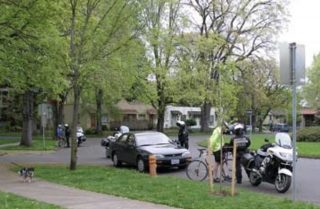
(Photos © J. Maus/BikePortland)
Ray Thomas is a partner at Thomas, Coon, Newton & Frost*.
Bjorn Warloe was living in Corvallis in 2003 and remembers reading a story in the Oregon State University student newspaper that Oregon had passed an “Idaho Stop” law which allows a bicycle user to treat a stop sign as a yield sign. It turned out the article was wrong (it had passed the House but had failed to even get a hearing in the Senate) though it did accurately identify Eugene Senator Floyd Prozanski as the legislation’s chief proponent.
Idaho Stop had failed, but the idea to correlate stop sign law with natural and safe riding behavior stuck with Bjorn. And 13 years later he would still be around to see a stops-as-yields law finally pass the Oregon legislature.
Here’s how it happened…

Four years after Bjorn first read that article, when he was living in the Ladd’s Addition neighborhood of Portland, he became frustrated that Portland police were citing bicycle users for stop sign violations on quiet neighborhood streets. It seemed like a huge misallocation of scarce law enforcement resources to enforce a law that did not make sense and to then not enforce laws that protected vulnerable users. Bjorn contacted Portland Bureau of Transportation bicycle planner Roger Geller to ask that the city remove the stop signs at Ladd’s Circle. When Roger detailed the engineering it would take (including interviews with the street-side residents who were complaining to the police about bike riders not stopping), it seemed like an impossible effort.
Advertisement
So in 2007, Bjorn contacted Scott Bricker who was then lobbyist for the Bicycle Transportation Alliance (now the Street Trust) and urged him to consider another legislative effort in Oregon, this time with more widespread grassroots support from the community. It was late in the session but both Senators Jason Atkinson (who in 2012 referred to himself as, “The most hardcore cycling fan who is also a registered Republican” and is now running for Congress) and Lane County Democrat Floyd Prozanski were receptive. Through the BTA Legislative Committee, Bjorn and other bicycle advocates worked to get the bill started.



While they were unsuccessful in 2007 (passing Oregon’s Vulnerable Road User Law was the organization’s top legislative priority that year), The Street Trust made Idaho Stop legislation a top priority during the next session in 2009 and put lobbyist Karl Rohde in charge of the effort.
This time around, an “Idaho Style” group formed by Bjorn had the advantage of excellent support materials. Jason Meggs, a UC Berkeley School of Public Health graduate student, had conducted a time-based comparison study of the effect of the Idaho Stop on injuries. In his research (titled simply “Stops Harm Bikes“) Meggs discovered a 14.5% decline in injuries after passage of the law in Idaho.
Another member of the Idaho Style group was Portland-based animator and illustrator Spencer Boomhower. He created an excellent video that displayed the logic behind the law change and published it online. The video quickly spread and became a key weapon that boosted awareness and respect for the concept.
Advertisement
With these tools at their disposal, the bill received a few hearings, but the idea became a lightning rod of controversy. It attracted anti-Portland sentiment among many legislators and ultimately failed to advance. The combined efforts of the Idaho Style proponents and The Street Trust’s lobbying was unsuccessful again. It was a dispiriting defeat. The Idaho Stop effort of 2009 turned out to be the last major traffic law reform to emerge from the The Street Trust’ss Legislative Committee (which was gradually dismantled after its new Executive Director, Rob Sadowsky, felt the grassroots pre-occupation with minutiae of Oregon traffic law took too much staff time that would be better spent on the Vision Zero movement).

While the Idaho Stop movement became dormant as the Street Trust focused its legislative efforts on major infrastructure and non-motorized transportation legislation for the next decade, Bjorn never stopped thinking about Idaho Stop. When he heard that Delaware passed its own version of the law in 2017, he wrote to Senator Floyd Prozanski and suggested it might be time to try again. Senator Prozanski knew that Oregon Democrats had a supermajority in the legislature and that he could use a placeholder bill – a bill drafted to provide a means to advance a new concept or amend an existing statute usually late in the session – to introduce a Delaware-style stop sign law. (Delaware Stop allows bicycle riders to treat a stop sign as a yield sign and yield the right-of-way to other vehicles before entering the intersection.)
When he learned that Arkansas had also passed its own Idaho Stop bill in March 2019, Prozanski saw an opportunity. “I figured if Arkansas can do it, a native Texan can get’er done in Oregon.” (Prozanski, who is also an avid road cyclist, drafted and shepherded the Oregon Safe Passing Law in 2007, which came about as the result of an unsafe pass by a log truck that caused the death of Eugene triathlete Jane Higdon.)
Bjorn, Prozanski and bicycle advocacy groups (including the Street Trust now led by Executive Director Jillian Detweiler) worked together to spread the word and considerable grassroots support arose for the measure. By the time Senate Bill 998 made it to the House Rules Committee, over 198 citizen letters had been submitted into the legislative record!
Less than five months after Bjorn contacted Senator Prozanski, the Oregon Legislature passed SB 998. (Even though the bill passed the Senate 21-8, it barely passed the House 31-28.) Prozanski’s staffer, Kevin Moore, observed, “I never saw Floyd beaming so much after a bill passage as he was after the House vote on SB 998.” On August 6, Governor Kate Brown signed the bill into law with an effective date of January 1, 2020.
Advertisement
Below is the salient text of the new law:
A person operating a bicycle who is approaching an intersection where traffic is controlled by a stop sign [or flashing red signal] may, without violating ORS 811.265, do any of the following without stopping if the person slows the bicycle to a safe speed:
(a) Proceed through the intersection.
(b) Make a right or left turn into a two-way street.
(c) Make a right or left turn into a one-way street in the direction of traffic upon the one-way street.
(2) A person commits the offense of improper entry into an intersection where traffic is controlled by a stop sign if the person does any of the following while proceeding as described in subsection (1) of this section:
(a) Fails to yield the right of way to traffic lawfully within the intersection or approaching so close as to constitute an immediate hazard;
(b) Disobeys the directions of a police officer or flagger, as defined in ORS 811.230;
(c) Fails to exercise care to avoid an accident; or
(d) Fails to yield the right of way to a pedestrian in an intersection or crosswalk under ORS 811.028.
(3) The offense described in this section, improper entry into an intersection where traffic is controlled by a stop sign, is a Class D traffic violation.
Keep in mind, the new law applies to stop signs and flashing red signals. It does not apply to standard traffic signals. Idaho added this provision in 2006 and many bicycle riders feel it’s a natural and logical extension of the stop sign provision. However, there are some bicycle advocates who worry that people may be less cautious if this aspect of the law was changed and would mistakenly ride into an intersection where other road users with a green light (who may have timed the light sequence) hit them and cause a major crash. On the other hand, the instinct for self-preservation comes to the forefront here; bicycle riders very rarely pull out in front of motor vehicle users. It also makes little sense for a bicyclist to sit at a red light waiting and waiting when there is no one to stop for.
When asked when he might add the signal to the law for Oregon as a next step, Senator Prozanski said, “Well, come see me in another few years on that one.” Since it appears Idaho’s signal law has been working well there for 13 years it is likely that the evolution of the Idaho Stop in Oregon will include further calls to add traffic signals into the equation.
Until then, enjoy your new freedom to yield at stop signs and flashing red signals. And remember to do it only after making sure it’s safe to do so.
For more on how Oregon got its Idaho Stop law, listen to Bjorn and I on a recent edition of the Sprocket Podcast.
— Ray Thomas
*TCN&F is a financial supporter of BikePortland
– Never miss a story. Sign-up for the daily BP Headlines email.
– BikePortland needs your support.


